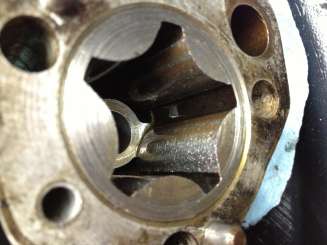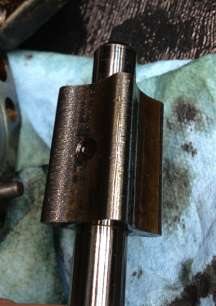The MGA With An Attitude
OIL PUMP INSPECTION - OF-107
This commonly starts with a question about low oil pressure at slow engine speed, perhaps 20 psi at idle. An MG engine in good condition may maintain about 40 psi oil pressure with hot idle, and should rise to relief pressure (50 psi or more) by 2000 or 2500 rpm. Since I keep a good oil pump in my engine, when the pressure at 800-1000 rpm idle is 20 pis and at road speed 40 psi, I figure it's time to change the crankshaft bearings (rods and mains).
The oil pan can be removed and bearings replaced with the engine in place in the car (with a little finesse). While you're in there mucking about, it's a good idea to inspect the oil pump, and if it doesn't need a new one don't waste your money buying it. By the book, running clearance between the rotors should not exceed 0.006", and rotor end clearance should not exceed 0.005". End clearance is seldom a problem, but if it is excessive it can be fixed by hand lapping the end of the housing (fine grit emery paper and oil on a flat surface). Proper radial clearance between the rotors is more important, and more often a problem. You can use thickness gauges to "feel" the space between the rotors. If this space is excessive the oil pump is trash. Replacement oil pump rotors are available as "oil pump rebuild kit".
If the end and side clearances are within spec, you still need to inspect the mating surfaces between the rotors. The contoured lobe surfaces should be smooth and free of scratches. If it looks like a hand full of coarse sand went through it, then it's probably trash. Such peripheral "scratches" are not always the result of debris passing through the pump. If it has for any reason been run with excessive oil pressure (greater than 80 psi) such damage to the pump rotors may occur by erosion of the metal from passage of the high pressure oil. Similar erosion damage can also occur in the soft metal surface of crankshaft bearings where it may appear as irregular worm holes in the bearing surface.

Photos showing serious wear in the oil pump rotors.
The mating surfaces should be smooth, not scratched.
(Photos by Ryan Kew)
|

|
If the oil pump passes the feeler gauge and visual inspection it is probably good to use, but you can also test to see if it will be self-priming. Wash the oil pump out clean with solvent, blow dry with compressed air and reassembly. Put the pickup end into a tub of mineral spirits and turn the input shaft by hand at 1 to 2 revolutions per second, for several seconds if necessary. When the inside of the pump is completely dry the normal clearance between the rotors of a new pump may pass enough air to prevent it from self priming, so don't be surprised if it doesn't work.
Then put little mineral spirits inside the pump and rotate it a few times to wet the rotors. Place the pickup end of the empty but wet pump in the tub of mineral spirits and turn the input shaft by hand again. If the pump will self prime and begin pumping at hand turning speed simply by being wet with mineral spirits, it is definitely a good oil pump.
If it doesn't self prime being wet with mineral spirits, you still have one more test. Put a little engine oil into the pump and rotate it a few times to wet the rotors. Place the pickup end of the empty but wet pump in the tub of mineral spirits and turn the input shaft by hand again. This time it should definitely self prime and start pumping. If it will not self prime when the rotors are wet with engine oil, it is definitely trash.
In between the last two conditions is a bit of gray area. If it does not self prime on mineral spirits, but it does self prime on oil, then it will work in the engine, but it may not produce the best desired pressure at engine idle speed. Then you get to make the judgment call, which may depend some on your finances and your intended use of the car. You might put it all back together with new bearings on the crankshaft and the old oil pump, and end up with 50 or 60 psi at road speed but only 30 psi at hot idle. That's when you get back to thinking about how much work it is to R&R the sump again to install a new oil pump. Knowing the condition of the pump in advance, you have the choice to buy a new one the first time around, or maybe intentionally install the old one and live with it for a while longer.
As with many things on your MG, knowing such things can make you more confident with slightly low idle oil pressure and more cash in your pocket, or with perfect oil pressure and a little less cash, your choice.
|